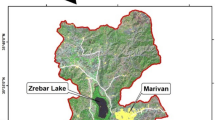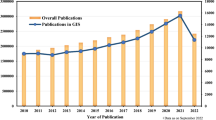Abstract
This chapter deals with information simplification after the union of several information layers within a geographic information system (GIS). The challenge is to have better visualization (spatial homogeneity) while keeping as much information as possible (semantic information). These two objectives are opposing. Each layer has a set of concepts attached to an ontology, allowing the computation of a semantic distance used to select the information. Each object (called an instance) in a layer is annotated with the concept of the layer and also with its spatial information (shape, localization, etc.). The proposed approach uses a two-phase multiobjective local search in an ascendant way starting from the most complete set of concepts or in a descendant way starting from the most simplified set of concepts. In this chapter, we use this technique for environmental applications in order to determine ecological units based on environmental and topological layers. These units are used to identify isolated or threatened ecosystems in tropical forests. We compare the quality of the results and the computation time with other approaches, such as genetic algorithms.
Access this chapter
Tax calculation will be finalised at checkout
Purchases are for personal use only
Similar content being viewed by others
References
Deb K, Pratap A, Agarwal S, Meyarivan T (2002) A fast and elitist multiobjective genetic algorithm: Nsga-ii. IEEE Trans Evol Comput 6:182–197
Fonseca FT, Egenhofer MJ (1999) Ontology-driven geographic information systems. In: Proceedings of the 7th ACM international symposium on advances in geographic information systems, ser. GIS’99. New York, ACM, pp 14–19, [Online]. Available: http://doi.acm.org/10.1145/320134.320137. Retrieved Nov 2011
Jadaan OA, Rajamani L, Rao CR (2008) Non-dominated ranked genetic algorithm for solving multi-objective optimization problems: NRGA, J Theoret Appl Inf Technol, pp 60–67
Liefooghe A, Paquete L, Simoes M, Figueira JR (2011) Connectedness and local search for bicriteria knapsack problems, EvoCOP 2011, LNCS 6622, pp 48–59
Miller HJ, Han J (2009) Geographic data mining and knowledge discovery, 2nd edn. CRC Press, Boca Raton
Noller C, Smith VR (1987) Ultraviolet selection pressure on earliest organisms. In: Kingston H, Fulling CP (eds) Natural environment background analysis. Oxford University Press, Oxford, pp 211–219
Segretier W, Collard M, Grandchamp E (2012) An heuristic-based approach for merging information layers in a GIS, Geoprocessing
Tomlin CD (1990) Geographic information systems and cartographic modelling. Prentice-Hall, Englewood Cliffs
Author information
Authors and Affiliations
Corresponding author
Editor information
Editors and Affiliations
Rights and permissions
Copyright information
© 2014 Springer-Verlag Berlin Heidelberg
About this chapter
Cite this chapter
Grandchamp, E., Fonseca-Cruz, E. (2014). A Two-Phase Multiobjective Local Search for GIS Information Fusion: Spatial Homogeneity and Semantic Information Tradeoff. In: Popovich, V., Claramunt, C., Schrenk, M., Korolenko, K. (eds) Information Fusion and Geographic Information Systems (IF AND GIS 2013). Lecture Notes in Geoinformation and Cartography. Springer, Berlin, Heidelberg. https://doi.org/10.1007/978-3-642-31833-7_10
Download citation
DOI: https://doi.org/10.1007/978-3-642-31833-7_10
Published:
Publisher Name: Springer, Berlin, Heidelberg
Print ISBN: 978-3-642-31832-0
Online ISBN: 978-3-642-31833-7
eBook Packages: Earth and Environmental ScienceEarth and Environmental Science (R0)




